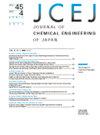超临界CO2条件下醋酸丙酯在活性炭上的吸附平衡
IF 1.2
4区 工程技术
Q4 ENGINEERING, CHEMICAL
引用次数: 0
摘要
由于许多经济和环境因素,用于吸附印刷工业中主要挥发性有机化合物(VOCs)的废活性炭的再生非常重要。超临界CO2 (scCO2)再生避免了常用的热再生方法所带来的高温,避免了高温对活性炭的破坏。然而,以往的研究只涵盖了有限的操作条件范围,为了更好地了解scCO2过程,需要进行更广泛的研究。本研究采用固定床吸附法,在313 K ~ 353 K、10 MPa ~ 20 MPa条件下,研究了乙酸丙酯在scCO2中的吸附平衡。我们的研究结果与之前关于温度和压力对吸附平衡影响的其他VOCs的报道一致。此外,采用Dubinin-Astakhov (DA)方程将实测数据与5.6%的平均相对偏差相关联。显然,乙酸丙酯的吸附量高于乙酸乙酯,但低于乙酸丁酯,这可能是由于它们对scCO2的挥发性不同以及对所用吸附剂的亲和力不同。本文章由计算机程序翻译,如有差异,请以英文原文为准。
Adsorption Equilibria of Propyl Acetate on Activated Carbon Under Supercritical CO2 Conditions
The regeneration of spent activated carbon used to adsorb alkyl acetates, which are the main volatile organic compounds (VOCs) used in the printing industry, is important because of numerous economic and environmental factors. Regeneration by supercritical CO2 (scCO2) avoids the high temperatures associated with the commonly used thermal regeneration method, which may damage the activated carbon. However, previous studies cover only a limited range of operating conditions, and more extensive research is required for better understanding the scCO2 process. In this study, the adsorption equilibria of propyl acetate on activated carbon in scCO2 were investigated using the fixed-bed adsorption method at 313 K–353 K and 10 MPa–20 MPa. Our results agree with previous reports of other VOCs on the effect of temperature and pressure on adsorption equilibria. Furthermore, the Dubinin–Astakhov (DA) equation is used to correlate the measured data with an average relative deviation of 5.6%. Evidently, the adsorbed amounts of propyl acetate are higher than those of ethyl acetate but lower than those of butyl acetate, which can be attributed to their different volatilities in scCO2 and different affinities for the used adsorbent.
求助全文
通过发布文献求助,成功后即可免费获取论文全文。
去求助
来源期刊

Journal of Chemical Engineering of Japan
工程技术-工程:化工
CiteScore
1.70
自引率
12.50%
发文量
51
审稿时长
1.9 months
期刊介绍:
The Journal of Chemical Engineering of Japan (JCEJ) is a monthly publication in English of the Society of Chemical Engineers, Japan. The first issue appeared in 1968. JCEJ publishes timely original research in the broad field of chemical engineering ranging from fundamental principles to practical applications. JCEJ is an international research journal and invites your contributions and subscriptions.
All areas of chemical engineering are covered, including:
Physical Properties and Physical Chemistry,
Transport Phenomena and Fluid Engineering,
Particle Engineering,
Separation Engineering,
Thermal Engineering,
Chemical Reaction Engineering,
Process Systems Engineering and Safety,
Biochemical,
Food and Medical Engineering,
Micro and Nano Systems,
Materials Engineering and Interfacial Phenomena,
Energy, Environment, and
Engineering Education.
 求助内容:
求助内容: 应助结果提醒方式:
应助结果提醒方式:


